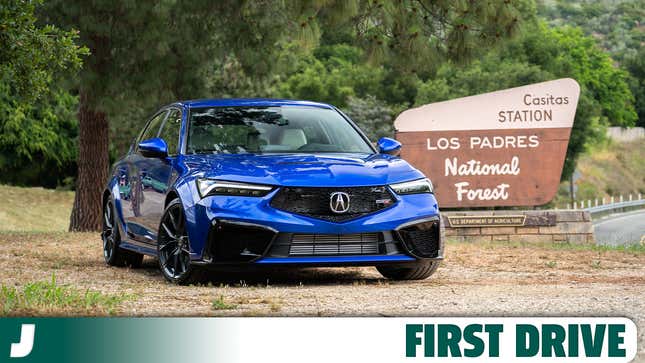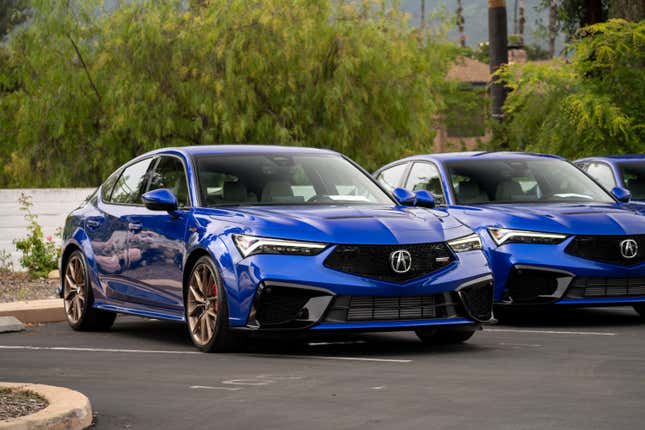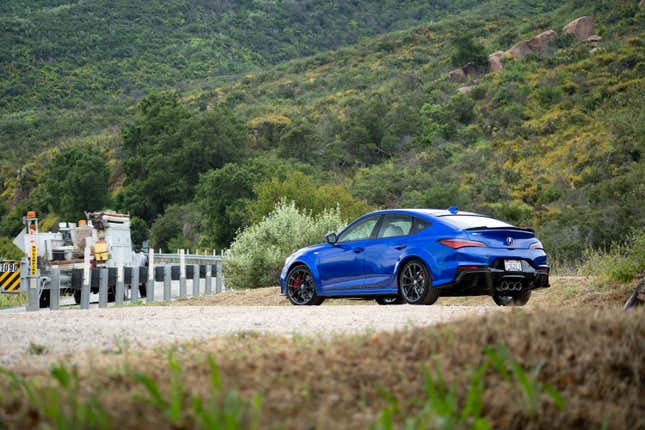
Car buying is hard. Especially right now, with inventory woes and dealers inventing prices off the tops of their heads, it’s often easier to start your shopping at home — reading reviews, impressions, and spec sheets, whittling down your options to the few cars worth actually going out and seeing.
But those spec sheets are bullshit. You can look at dyno charts and legroom dimensions all day, and none will really tell you what it’s like to drive the car. Case in point, the new Acura Integra Type S: On paper, it’s an up-spec Civic Type R. On the road, it might just be the perfect car.
Full Disclosure: Acura flew me out to Ojai Valley, CA to test the new Integra Type S. They paid for my food, hotel, airfare, and surprisingly long-yet-beautiful ride from LAX. Turns out California is big.

What’s New About The 2024 Acura Integra Type S?
Naysayers will tell you nothing about this car is new, it’s all borrowed from the Civic. Acura will tell you that much of the car is brand-new for the Integra line, with everything from the drivetrain to the body panels to the seats being freshly introduced for the Type S. The answer, as is usually the case with these things, lies somewhere in the middle.
The big change with the Type S is the drivetrain. The car gets the same 2.0-liter turbo four and six-speed manual transmission as the Civic Type R, so the naysayers nab a point there. But to tie up the game, the Integra makes more power, has a better exhaust note, and retains the always-excellent Honda shift feel.

To tip the scales further towards Acura’s side, there’s more to the Type S than an engine. Its suspension is automatically adjustable, like the standard Integra, but it gets far stiffer than in any of that car’s modes. Even the Comfort setting in the Type S seems intent on reminding you that you shelled out the extra cash for the performance version - you won’t be spilling your drink over bumps, but there’s no forgetting you’re in the Fast One. In Sport+, it’s nearly Type R-stiff.
The brakes are upgraded beyond those of the A-Spec, big Brembo calipers squeezing four pistons onto rotors the size of a Miata wheel, and they hide behind lightweight 19-inch wheels that fill widened, flared fenders. The whole car is 2.8 inches wider than the base car, allowing Acura to widen the track by 3.5 inches up front and 1.9 in the rear. All this for extra grip — grip you can truly feel while driving.

What Are the Specs?
The Integra Type S makes 320 horsepower at 6,000 RPM and 310 lb-ft of torque, flat from 2,600 all the way to 4,000 on the tach. It’s 186 inches long, 74.8 inches wide, 55.4 inches tall, and weighs 3,219 lbs. It has 37.4 inches of rear legroom, the stereo has 16 speakers, and the reverse gear ratio is 3.757:1. None of this matters.
I can tell you that the Integra Type S makes more horsepower than an M235i Gran Coupe, that it has more torque than an Audi S3, or that it’s lighter than a Golf R. But no spec sheet will tell you about the feeling through the Integra’s front wheels as the limited-slip differential forces that power to the ground; no single numerical value can quantify the way the rear end kicks out in a tight corner. The specs on the Type S are impressive, but this — more than maybe any other — is a car that’s so much more than its specs.

How Does It Look?
Gorgeous. The standard Integra is already a nice-looking five-door, but the Type S rework truly changes the car’s visual character. The wide front intakes, the enlarged grille, the big fenders — they all give the Type S an aggressive, almost brutish look. There’s no confusing it with the base model, and no mistaking it for any staid people-mover. It looks mean.
My tester was done up in Apex Blue, which would be my choice were I to buy one. It’s a color shared with the base car (only the Tiger Eye yellow is exclusive to the Type S), but it’s a great enough hue that I’m not complaining. I do, however, recommend the optional accessory copper wheels that my tester didn’t have. Maybe it’s just the former Subaru owner in me, but blue and copper is just a beautiful combo.

How Does It Drive?
Better than it has any right or reason to. When I say the specs don’t matter, I mean there’s no way a 3,200-lb, 320-horsepower car should feel this good. Through a twisty canyon road, the Type S is the devil on your shoulder, always telling you to go faster, corner harder, brake later and carry more speed. It’s never unsettled by what you throw at it — enter a corner too hot, slam on the brakes too hard, crank the wheel too far, it doesn’t matter. The Integra remains composed through it all. If you’re lucky, the car may even forget it’s front-driven for a minute, and kick the tail out like a BRZ.
Of course, entering a corner too hot is easier said than done. The Brembo brakes are truly fantastic — not on the level of something like the Focus RS, sure, but that would be overkill on a car unlikely to see much track time.

The suspension never feels unsettled, keeping pace with every bump and turn the California canyons throw at it, and the grip from the front end is truly something special to feel as it pulls you through to the corner exit. The steering through those corners is more muted than the Civic Type R, less communicative, but far from being boring.
More than anything, though, the Integra truly feels like it wants to be doing this. When Honda revamped the Civic Type R from the FK8 generation to the FL5, that car became more serious — less playful and goading, more focused on lap time supremacy. The Integra splits that difference, feeling more raucous than the FL5 without being as childish as the FK8. Its exhaust pops and burbles on deceleration, its shifter feels so good slotting its way through the gears, the car effortlessly accelerates to speeds far higher than you ever meant to hit. Through it all, though, the Integra only asks one question: “C’mon, is that it?” If you liked the impish character of the Veloster N, but want something built for adults, here’s your car.

How’s The Interior?
There’s something difficult to describe about the Integra’s interior. I’ve spent plenty of time in these cars — I reviewed one at the initial press launch, Acura handed me the keys to one for Pikes Peak, and now this — and each time something has just felt right. Truthfully there isn’t much to differentiate its design from the Civic, beyond some revised vents and nicer materials, but the car always somehow ends up feeling like home. The Type S seats, with their improved bolstering for cornering comfort, manage to make the interior even nicer. It fits me, it’s a fantastic place to be.
As my drive in the Type S began to wrap up, and I traversed the last few miles of the drive route, the clouds that had plagued the whole day started growing darker and more ominous. Normally that’s a sign to head home — get out of the car, and into the hotel, before the skies open up. But in the Integra, all I thought was how nice it would be to spend a rain storm in that driver’s seat. Pull off somewhere, crank the stereo, and just let the drops pound down on the roof. A car must be pretty damn comfortable to make sitting still in the rain tempting.

How Does It Compare to the Competition?
Among its competitors, the Type S is a bit of an oddball. Its $50,800 MSRP is more expensive than the $46,800 Audi S3 or $47,600 BMW M235i Gran Coupe, and it comes at the additional cost of driven wheels — both of those options send power to all four corners. The pitch, then, is that the Integra is neither the budget option nor the luxury choice. Out of the entry-luxury-performance segment, the Integra is the true driver’s car.
The other big competitor to the Integra comes from inside the house — the Civic Type R, which can go nearly spec-for-spec with its upscale sibling. But even the toned-down looks of the FL5 Civic don’t fit in everywhere as well as the Type S’s aggressive-yet-classy exterior does. The Civic is less comfortable, more focused on all-out speed in track driving. It’s likely faster around a track than the Integra, but I’d rather take the Acura to work. Your choice will depend on which of those matters more to you.

Final Thoughts
Too often, we get wrapped up in numbers. Horsepower, torque, weight, area under the curve. These are all important enough, but they don’t tell the full story — and sometimes, they hide the best parts of a car. Honda and Acura have shown this time and time again, building cars that punch well above their weight class on speed, handling, and comfort.
The Integra Type S is one of those cars. It’s faster than you assume it will be, more comfortable than its stiff suspension would suggest, and just so much fun to chuck around. The car is a comfortable, enjoyable place to spend your time, and if you get the opportunity to push it through the twisties it’ll reward you like few other cars can.
But there’s an elephant in the room, one whose trumpet sounds suspiciously like the words “$52,000 after destination.” That’s more than Type R money, more than you’d pay for the Integra’s German competition. For $7,000 less, why not just get the Civic? If I had the money, and were in the market for a four-door sporting car, it’s something I’d have to spend a long time considering.

And, for this review, I have. For nearly two weeks, I’ve been thinking about the Integra and the Civic and which I’d rather own. When it truly comes down to it, does my 26-year-old back really need the Integra’s additional comfort? Do I actually prefer the Type R seats? Does the Integra add seven grand worth of value above the Civic?
Yes, it does. The Acura’s exhaust note alone starts to make up the gap, and the car’s raucous nature quickly joins in. It’s more comfortable than the Civic while somehow being more entertaining at legal speeds — the speeds you and I actually drive on a regular basis. The Type R can only be fully uncorked on track, but the Integra doesn’t need ten tenths driving to put a grin on your face.
Driving the Type R, when my time was up, I brought the car back to the paddock and handed it off to the next driver. In the Integra, I slowed to a crawl as I approached the drive route’s end — I didn’t want to give the car back. I still don’t. For my imaginary, hypothetical money, give me the Integra Type S any day.
